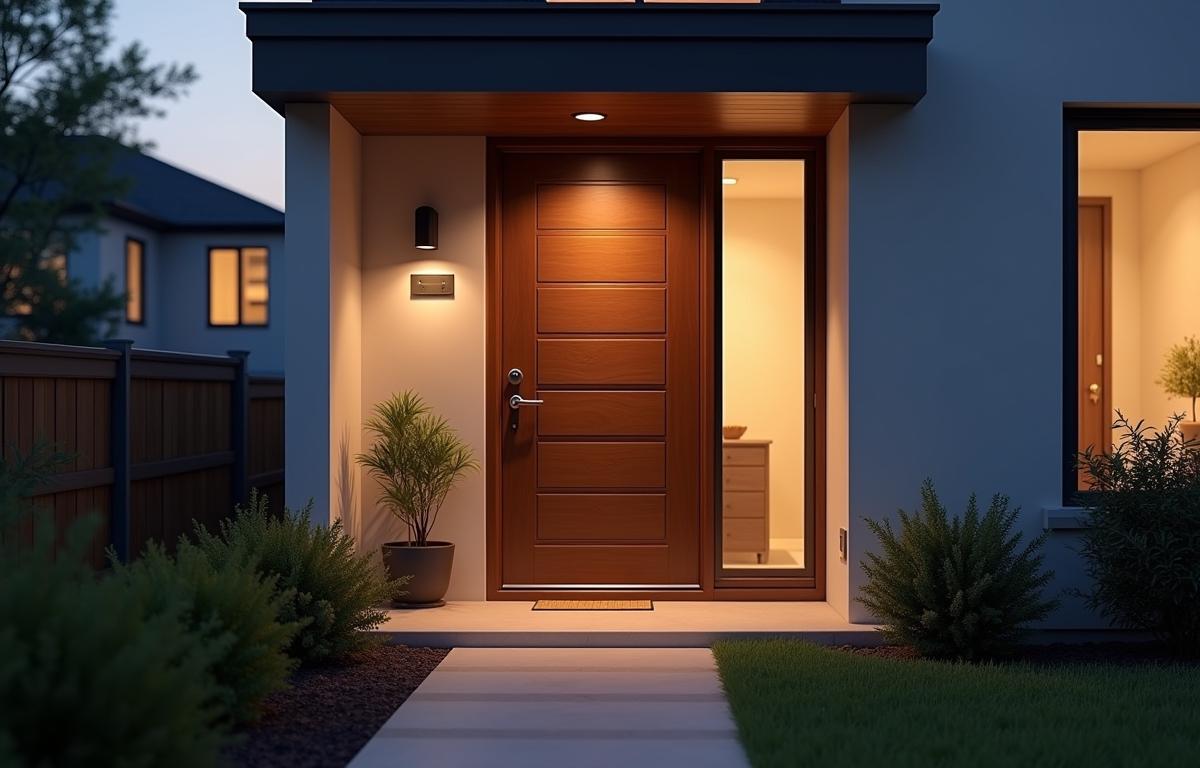Essential Home Security Features for First-Time Buyers
When buying your first home, consider the importance of key security features. That sense of comfort you get from knowing your living space is well-guarded against intruders or unexpected incidents can ease many late-night worries. Beyond that, taking steps to secure your property can yield tangible benefits, such as reduced insurance costs and a safer neighborhood environment. By learning to spot potential vulnerabilities and invest in the right technology, you’ll take control of your peace of mind today and well into the future.
For newcomers, it might be difficult to decide which options truly matter. Perhaps you’ve heard about everything from video doorbells and smart lighting to heavy-duty deadbolts and motion alarms. Sorting through these choices can seem overwhelming, especially when you’re busy settling into a new house, learning the neighborhood layout, and adjusting to your surroundings. With the right suggestions, though, you can streamline your approach and set up a robust defense without going overboard.
Contents
- 1 The Importance of a Strong Entrance
- 2 Securing Windows and Doors Throughout the House
- 3 Embracing Modern Technology for Peace of Mind
- 4 Outdoor Security and Perimeter Protection
- 5 Maintaining Your System and Staying Informed
- 6 Additional Tips for Ongoing Confidence
- 7 Safeguarding a New Home for Your Future
The Importance of a Strong Entrance
Securing exterior doors is a smart place to start. Many first-time buyers focus on renovating kitchens or repainting walls before they pay attention to door design and locks. Yet the moment you upgrade to sturdy hardware and pick materials that keep intruders at bay, you’ll notice how pivotal a solid entrance can be.
Entry Doors and Solid Materials
Your main entrance should rely on durable material. Solid wood, fiberglass, or steel cores have fewer weak points than hollow alternatives. While it may appear more expensive initially, these options last longer and require fewer replacements or repairs over time. They also make it far harder for anyone to force their way inside.
Smart Locks and Reinforcements
Including updated door hardware can make life easier. Smart locks let you enter with keypads or smartphone apps, often giving you real-time alerts if someone attempts to mess with the lock. Reinforcing door frames and adding better strike plates further boost security, keeping your threshold intact even when force is applied. Combining hardware improvements with technology-driven solutions creates a robust barrier that doesn’t rely on a single point of failure.
Securing Windows and Doors Throughout the House
Doors deserve plenty of attention, but windows mustn’t be overlooked. Flimsy latches or loose frames can offer easy access points for determined intruders. Inspect every exit in your home and address weaknesses that could undermine even the best home alarm system.
Window Locks and Upgrades
Standard window locks are often flimsy. Consider investing in advanced locks or specialized hardware if you live in an area with higher break-in rates. Laminated or tempered glass provides extra strength and resists shattering. While glass might always be a point of vulnerability, every bit of protection reduces the chance of a breach.
Sliding Door Security
Sliding doors are another popular target, because they often feature single locks that can be pried open. By installing a secondary lock or placing a secure bar in the track, you can make it much tougher for anyone to slide the door open from the outside. These fixes are usually inexpensive yet critical for keeping potential intruders at bay.
Embracing Modern Technology for Peace of Mind
Technology has come a long way, and modern home security solutions reflect that shift. With quieter operation, remote access, and user-friendly interfaces, today’s systems are simpler to manage and more effective overall. By blending tradition and innovation, you gain extra layers of protection without the hassle of complicated wiring or paying for professional installation you might not need.
Home Security Cameras and Video Doorbells
A camera at your front door can capture clear images of anyone knocking or leaving packages. The convenience of real-time notifications allows you to see who’s there, no matter where you happen to be. Some video doorbells also record short clips, so even if you’re not checking the feed at the moment, you can review questionable activities. Adding cameras in strategic areas around the house, like side entrances or backyards, expands your surveillance net.
DIY Security Systems
Many first-time buyers appreciate do-it-yourself alarm kits that arrive with motion detectors, entry sensors, and central hubs for monitoring. Setup can be straightforward, and you can often customize each system with additional equipment. While professional monitoring improves response times, even a budget-friendly DIY approach can work wonders if installed correctly. Adjust the devices over time to fit your comfort level and meet your evolving needs.
Outdoor Security and Perimeter Protection
Focusing only on the house’s interior can overlook the value of a secure perimeter. Outdoor lighting, well-placed fences, and clear sightlines often deter suspicious activity before it reaches your doorstep. Being proactive about your property boundaries also sends a message that you take security seriously.
Landscape Lighting
Bright but energy-efficient lighting around walkways, driveways, or gardens does more than help you watch your step at night it also eliminates dark corners where someone might hide. Motion-activated fixtures, especially near entrances, startle potential trespassers and notify you of activity. Pair them with solar panels if possible, cutting down on energy consumption while still providing illumination after sundown.
Fencing and Gates
A fence acts as a physical barrier and sets a clear boundary around your property. Taller fences, combined with locked gates, discourage casual trespassers from wandering through. Avoid blocking your view with solid panels that create blind spots. Instead, choose designs that maintain visibility so anyone lurking near the fence is more easily spotted.
Maintaining Your System and Staying Informed
Even the best equipment needs tending to remain reliable. Technology updates, cleaning camera lenses, and replacing batteries ensure each device performs at its highest level. Staying updated on local crime trends and community discussions also helps you optimize your security measures.
Regular Self-Checks
It’s easy to neglect your alarm system once your daily routine takes over, but periodic checks reduce the risk of problems slipping under the radar. Test sensors and adjust their positions if they appear less responsive. Dust or debris can accumulate on cameras or motion detectors, so clean them gently from time to time. A quick monthly checklist can cut down on false alarms and missed threats.
Neighborhood Awareness
Keep an ear to the ground by joining local social media groups or chatting with neighbors. Being aware of unusual activity in the community helps everybody stay safe, and you can work together to watch out for each other’s property. If you see a sudden rise in vehicle break-ins, for instance, you might enhance your camera coverage or add stronger locks to sheds and garages.
Additional Tips for Ongoing Confidence
Finding the right system for your household doesn’t have to break the bank or overwhelm you with endless gadgets. Sometimes, simple upgrades and mindful habits offer the best start. From building good daily routines to ensuring you’ve filled small gaps, it’s about balancing practicality with reliable security.
Layered Security Approaches
Layered means diversifying how you protect your property. This could involve a simple camera together with smart locks and motion lighting. If one layer fails maybe a camera runs out of battery another layer like a door sensor could keep watch. Combining different methods creates a well-rounded defense that covers blind spots on multiple levels.
Quick Habits That Make a Difference
Locking doors and windows whenever you leave the house may sound obvious. But in practice, it’s easy to forget, especially if you’re rushing out. Make double-checking locks part of your daily routine. If you need reminders, set alarms on your phone or hang a small checklist by the exit to cultivate the habit.
Small Adjustments for Better Protection
Keep valuables away from windows, especially if they’re easily visible from the street. When you travel, ask a neighbor to pick up mail or packages so they don’t pile up. Install curtains or blinds that keep prying eyes away. These small actions might seem minor, but they collectively build a strong deterrent against opportunistic intruders.
Safeguarding a New Home for Your Future
Once you realize how each part of your home can work in harmony to protect you, investing in the right solutions becomes more purposeful. There’s something empowering about walking through your front door each day and knowing that the choices you made reinforce your household’s safety. Even something as simple as a well-lit walkway adds a sense of welcome and caution that can’t be replicated by neglected spaces.
Remember that safety evolves with time. If you upgrade your technology or add a new system, don’t forget to integrate it holistically. Everything from your window locks to your phone alerts should complement each other, guaranteeing a smoother user experience. The more comfortable you become with your routine checks and maintenance, the more those potential worries fade away, leaving you free to enjoy your home.
As a first-time buyer, strengthening your security might feel daunting, yet it’s crucial for long-term peace of mind. Focusing on both fundamentals and modern enhancements will help you protect your family, shield your belongings, and even boost your property value. By keeping these ideas in mind and staying attentive to your home’s unique needs, you’ll find a balanced system that works best for you.

